 Environmentalists welcomed the end of Longannet, which burned around 4.5 million metric tons of coal a year, and was responsible for a fifth of Scotland’s climate change emissions. For a country which virtually invented the Industrial Revolution and for which coal had been central to the country’s economy for the past two centuries, this is a hugely significant step, marking the end of coal and the beginning of the end for fossil fuels in Scotland. With the closure of Longannet, the only major fossil fuel plant in Scotland is a gas plant at Peterhead, in the northeast.In the U.S. moving beyond coal continues with 232 plants announced for retirement.
Environmentalists welcomed the end of Longannet, which burned around 4.5 million metric tons of coal a year, and was responsible for a fifth of Scotland’s climate change emissions. For a country which virtually invented the Industrial Revolution and for which coal had been central to the country’s economy for the past two centuries, this is a hugely significant step, marking the end of coal and the beginning of the end for fossil fuels in Scotland. With the closure of Longannet, the only major fossil fuel plant in Scotland is a gas plant at Peterhead, in the northeast.In the U.S. moving beyond coal continues with 232 plants announced for retirement. Environmentalists welcomed the end of Longannet, which burned around 4.5 million metric tons of coal a year, and was responsible for a fifth of Scotland’s climate change emissions. For a country which virtually invented the Industrial Revolution and for which coal had been central to the country’s economy for the past two centuries, this is a hugely significant step, marking the end of coal and the beginning of the end for fossil fuels in Scotland. With the closure of Longannet, the only major fossil fuel plant in Scotland is a gas plant at Peterhead, in the northeast.In the U.S. moving beyond coal continues with 232 plants announced for retirement.
Environmentalists welcomed the end of Longannet, which burned around 4.5 million metric tons of coal a year, and was responsible for a fifth of Scotland’s climate change emissions. For a country which virtually invented the Industrial Revolution and for which coal had been central to the country’s economy for the past two centuries, this is a hugely significant step, marking the end of coal and the beginning of the end for fossil fuels in Scotland. With the closure of Longannet, the only major fossil fuel plant in Scotland is a gas plant at Peterhead, in the northeast.In the U.S. moving beyond coal continues with 232 plants announced for retirement.Posted in Coal, Renewables | Tagged Texas |
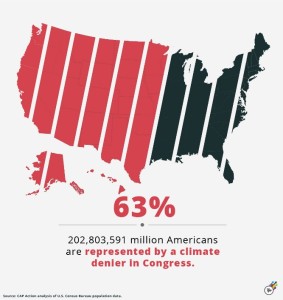
2014 and 2015 were back-to-back years that both earned the title for hottest year on record. and February 2016 was the warmest month, globally, ever recorded. And yet U.S. lawmakers continue to deny the facts. Earlier this month, the Center for American Progress Action Fund (CAPAF) released an analysis of climate change denial in U.S. Congress called “The 2016 Anti-Science Climate Denier Caucus.” Their research found that more than 63% of Americans are represented by someone in Congress who denies that climate change exists.
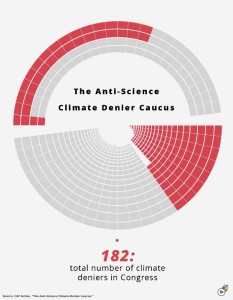 182 members of Congress don’t believe the science behind climate change: 144 members in the House of Representatives and 38 members in the Senate. 67% of Americans want the U.S. to take action on climate change, but 202 million citizens are represented in Congress by a climate change denier. Since the Republican Party’s platform on environmental policy never mentions climate change, it’s no surprise that every single denier is a member of the Republican Party.
182 members of Congress don’t believe the science behind climate change: 144 members in the House of Representatives and 38 members in the Senate. 67% of Americans want the U.S. to take action on climate change, but 202 million citizens are represented in Congress by a climate change denier. Since the Republican Party’s platform on environmental policy never mentions climate change, it’s no surprise that every single denier is a member of the Republican Party.
A recent poll revealed that 76% of Americans believe global climate change is occurring, including 59% of Republicans. According to a poll by NBC News and the Wall Street Journal, 67% of Americans support President Obama’s Clean Power Plan. The results of these polls don’t correlate with the fact that that the number of Congressional climate deniers has increased from previous years. From severe weather, wildfires, drought, and flooding, climate change is impacting Americans every day, and it’s evident that human activity is the dominant cause. Despite this evidence, 70% of the Senate GOP still denies climate change.
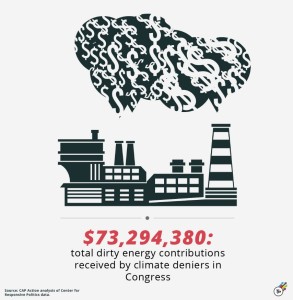 In the analysis, CAPAF also looked into dirty energy money’s influence over Congress members. They found that climate deniers in Congress received more than $73 million in contributions from coal, oil, and gas companies. This is an increase of nearly $10 million from last year. When asked about their views on climate change, many deniers dodge the question by saying “they aren’t scientists”.
In the analysis, CAPAF also looked into dirty energy money’s influence over Congress members. They found that climate deniers in Congress received more than $73 million in contributions from coal, oil, and gas companies. This is an increase of nearly $10 million from last year. When asked about their views on climate change, many deniers dodge the question by saying “they aren’t scientists”.
According to Sondre Båtstrand, a Norwegian researcher, the U.S. Republican Party is the only conservative party in the world which denies the reality of climate change. Båtstrand believes the GOP’s denial is due to three factors: the fossil fuel industry’s political spending, a commitment to free-market ideology, and the intense political polarization that punishes moderate-minded party members.
In February 2016, over 200 lawmakers in U.S. Congress signed onto a court brief opposing the president’s Clean Power Plan. At the end of 2015, the House of Representatives passed two resolutions to kill the Clean Power Plan. The Plan would regulate power plants’ carbon emissions and 67% of Americans support it. So it’s clear that Congress isn’t working the way it’s intended to. Members of the House and Senate are elected to represent the interests of American citizens, not their own fat wallets and the interests of dirty energy companies.
Regarding the state of Texas specifically, the 2016 Anti-Science Climate Denier Caucus found that 17 out of 38 Texas Congressional members are climate change deniers. In 2016, this is not only unacceptable, but is dangerous for Texas families who depend on their elected leaders to protect their futures. When the impacts of climate change become more and more apparent each year – more severe storms, deadly wildfires, crippling drought, and rising sea level – it’s clear there’s no time to waste. Climate change deniers in Congress, like Ted Cruz, stand in the way of these common sense safeguards. Texans and Americans across the country deserve leaders who will stand up to face this threat head on – not those following the playbook of their largest campaign donors.
Posted in Climate Change, Energy, Ethics, Global Warming, Good Government, Texas Legislature | Tagged Texas |
 Please join Manage Austin Better and Change Austin next Thursday, March 24, for a citizens’ hearing to provide your views on how Austin’s city management is running our city. Unfortunately, the Austin City Council is not providing you an opportunity to speak at a public hearing on city management, so Manage Austin Better, Change Austin, and other groups are.
Please join Manage Austin Better and Change Austin next Thursday, March 24, for a citizens’ hearing to provide your views on how Austin’s city management is running our city. Unfortunately, the Austin City Council is not providing you an opportunity to speak at a public hearing on city management, so Manage Austin Better, Change Austin, and other groups are.
It is your city and you pay for the services – so your views matter. Please come and voice your opinions. The event will be recorded for Council viewing.
The Citizen’s Hearing on Why the 10-1 Council Needs New Management
Thursday, March 24, 2016
6:30 to 8:30 pm
Austin Energy Community Room
721 Barton Springs Road
Please reserve a free seat at www.ChangeAustin.org. And please fill out our city manager evaluation form here, which Manage Austin Better will also deliver to council.
Posted in Global Warming | Tagged Texas |
 Wind knocked out nuclear to take third place as one of the major sources of energy in the Electric Reliability Council of Texas (ERCOT)’s system this year. ERCOT is the grid manager for the bulk of the state of Texas and stays on top of which power source is feeding into the grid at any given moment. Nuclear power met 15.1% of demand last month, coming in fourth behind natural gas, wind and coal.
Wind knocked out nuclear to take third place as one of the major sources of energy in the Electric Reliability Council of Texas (ERCOT)’s system this year. ERCOT is the grid manager for the bulk of the state of Texas and stays on top of which power source is feeding into the grid at any given moment. Nuclear power met 15.1% of demand last month, coming in fourth behind natural gas, wind and coal.
In February 2015, wind supplied only 11.8% of ERCOT’s demand, behind natural gas at 47.6%, coal at 26.5%, and nuclear energy at 13.7%.
Led by Texas, the U.S. wind industry is booming and is expected to continue record expansion into the early 2020s due to the recent 5 year extension and phase out of its $0.023/kWh production tax credit.
Texas added 3,615 MW of new capacity in 2015, more than twice of Oklahoma’s total of 1,402 MW, according to the American Wind Energy Association. Texas now has an installed capacity of more than 17,713 MW, more than twice of Iowa’s 6,212 MW. Texas also had 53% of all U.S. wind capacity under construction at the end of 2015.
Due to a mild winter in Texas, demand declined in February. ERCOT’s system demand peaked on February 4 at 47,397 MW, down from the previous month’s demand peak of 49,250 MW on January 11 and the demand peak around same time last year at 54,539 MW.
A quick recap of the above:
- Electricity demand in the Electric Reliability Council of Texas (ERCOT) fell February, but wind energy increased to supply nearly one out of every 5 MW of energy.
- Compared to February 2015, the ERCOT system used nearly 4.7 TWh of wind energy February, 14.3% more than the amount of wind energy generated at the same period last year, according to according to ERCOT’s monthly Demand and Energy report.
- Wind composed 19.9% of total energy on ERCOT’s grid in February, behind natural gas, which led with 43.2% of February demand, and coal, which supplied 21.2%.
Solar is making some inroads into the state’s power portfolio, but has not had the policy boost that wind got in 2005 with the passage of the Renewable Portfolio Standard (RPS). Nevertheless, with costs coming down and with investments nationwide in utility scale solar “farms”, yet another renewable source is becoming a viable option for replacing fossil fuel sources of electricity. In another 10 years, Texas’ energy portfolio could look very different from that of 2015.
Posted in Coal, Energy, Global Warming, renewable portfolio standard, Renewables | Tagged Texas |
As a global industry, aviation produces 2% of the planet’s total carbon dioxide emissions. Its outlook isn’t good either, because it’s projected to grow by 3-4% each year as the industry expands. While air travel has become 70% more efficient per seat-mile than when jets first began operating in the 1960s, the industry’s growth has resulted in higher overall CO2 emissions.
NASA’s project LeapTech is in the process of testing a new approach to powering flight. The concept is called distributed propulsion, and it’s the future of low-carbon aviation.  The project features a 30-foot airplane wing – the kind found on a small plane. The new wing design has 18 electric motors with small propellers along its leading edge.
The project features a 30-foot airplane wing – the kind found on a small plane. The new wing design has 18 electric motors with small propellers along its leading edge.
Engineers attached the wing to steel supports on a Peterbilt truck, and have been simulating takeoff and landings at the Edwards Air Force Base in California. They have driven the wing-truck contraption down the runway at more than 70 miles-per-hour.
The idea behind distributed propulsion is to take the engines from their usual position hanging below the wings and put them elsewhere. Because jet engines are complex, heavy devices, distributed propulsion designs almost always involve simpler and smaller electric motors.
 Distributing the motors around the plane (instead of in just one spot) has aerodynamic advantages. The position of the motors on the leading (front) edge of the LeapTech wing results in accelerated airflow over it, which increases lift at takeoff and landing. Because of this, the wing can be made narrower, which reduces drag and improves efficiency at cruising speeds.
Distributing the motors around the plane (instead of in just one spot) has aerodynamic advantages. The position of the motors on the leading (front) edge of the LeapTech wing results in accelerated airflow over it, which increases lift at takeoff and landing. Because of this, the wing can be made narrower, which reduces drag and improves efficiency at cruising speeds.
In terms of reducing an airplane’s carbon footprint, the key is cutting down on the plane’s weight and drag, and reducing the engine’s excess fuel burn. Some planes have been partly redesigned. In the coming years, Boeing will introduce the 777x, a variant of their 777 model. However, the new design of the 777x features composite wings and more efficient engines than the traditional 777. But the basic design of airplanes still remains the same – a tube and wings.
Besides NASA’s LeapTech project, there have been other innovations in airplane technology. Engineers have made planes lighter by using composite materials, jet engines have become more efficient, and alternative biofuels are increasingly being used. Better management of airplane traffic at airports and in the air has also reduced emissions. Many of the aviation industry’s improvements involve changes to existing planes though – like replacing older engines with more efficient models, or adding winglets to wings to reduce drag and improve efficiency.
In the future, NASA thinks that planes could be powered by hybrid gas-electric systems or by batteries. Potential designs could have lighter wings that can quickly shape to handle turbulent air. Other concepts could eliminate the conventional tube and wing design for one that blends the two elements.
For NASA, the next step is modifying an actual aircraft to operate with batteries and wing motors. NASA’s LeapTech project uses batteries, but the modified aircraft will only be able to make short flights because of the current limitations of batteries. All-electric planes may never be a practical option, but a hybrid turbine-battery design could be a reality.
Despite these scientific advancements, emissions from the aviation industry are still growing at a rapid pace. The International Civil Aviation Organization, a United Nations agency, projects that the worldwide commercial fleet will double to 40,000 airliners in the next 15 years. A recent report from the European Parliament revealed that international aviation could be responsible for more than 20% of global CO2 emissions in the near future. Aviation emissions impact cloud formation, ozone generation, and methane reduction, so the report’s projection isn’t a good sign.
In order to deal with the rising growth of the aviation industry, we must make drastic changes to airplane design to protect the environment. NASA’s LeapTech project is a step in the right direction towards making airplanes more eco-friendly, and more airplane engineering companies should take note.
Posted in Climate Change, Global Warming, Transportation | Tagged Texas |
Today, Supreme Court Chief Justice John Roberts rejected a plea to stay or enjoin further operation of the Mercury and Air Toxics rule. This is a big victory for the Obama administration, the EPA and environmentalists.
Roberts’s order came despite his court’s 5-4 decision last year ruling that the Environmental Protection Agency’s (EPA) regulation, known as the Mercury and Air Toxics Standards, is illegal, and he acted swiftly, waiting less than a day after the EPA’s response brief to side with the Obama administration. Furthermore, Roberts acted unilaterally, electing to reject the request himself rather than take it to the full court, which may have led to a 4-4 split following Justice Antonin Scalia’s death.
The mercury pollution standards, made final in 2012, are a separate regulation from the more controversial and costly carbon dioxide limits for power plants that are also being litigated in court.
The Supreme Court put an unprecedented halt to the carbon rule, known as the Clean Power Plan, last month by a 5-4 vote, when Roberts chose to let the full court vote on the matter. Thursday’s action by Roberts is completely separate from that case and the EPA says it plans to finalize a fix to the rule to retroactively apply its cost-benefit analysis in the way the Supreme Court said was necessary by next month which should move the rule forward toward protecting public health.
Posted in Air Quality, Coal Plants, Global Warming | Tagged Texas |
Solar energy is now more affordable than fossil fuels, even without accounting for the costs to the environment and public health. While creating electricity from solar energy has significantly dropped in price, the cost of producing electricity from coal has increased many places in the world, including the U.S. As a result the solar industry is rapidly expanding.
The cost to install solar is 73 percent lower than prices it was ten years ago, and it is becoming ever more affordable for both homeowners and businesses to install solar. Renewable power capacity has made up more than half of all global additions to the power market each year since 2013. In the United States, solar energy supplied 29.5 percent of all new electricity generation in 2015, and outpaced natural gas-fired generation additions for the first time. The U.S. market for solar is expected to double in 2016 and here in Texas, wind and solar are each projected to add more capacity than natural gas in 2016. Longer-term worldwide forecasts are also positive. The 2015 IEA World Energy Outlook predicts 26 percent of all power will come from renewable energy by 2020 and Bloomberg predicts that 35 percent of all new power capacity worldwide over the next 25 years will come from solar. It is clear that renewable energy will make up a large portion of the energy sector in the near future.
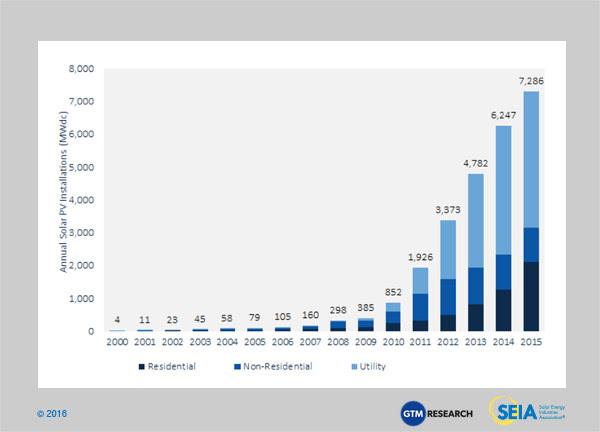
The success of the solar industry is good news for environmental reasons, but also for economic development. Already there are 208,859 solar jobs nationwide. Texas is one of the top ten states, with 7,030 solar jobs in 2015.
Census 2015 found that the industry continues to exceed growth expectations, adding workers at a rate nearly 12 times faster than the overall economy and accounting for 1.2% of all jobs created in the U.S. over the past year.
Strong growth in solar jobs is projected to continue. Surveyed solar industry employers in the U.S. expect solar jobs to increase by 14.7%, or 239,625 workers, in 2016. A report from the University of California shows that if 20 percent of U.S. energy came from renewable sources by 2020 20 percent and between 101,630 and 154,480 additional energy jobs would be created, compared to continuing with the current energy mix.
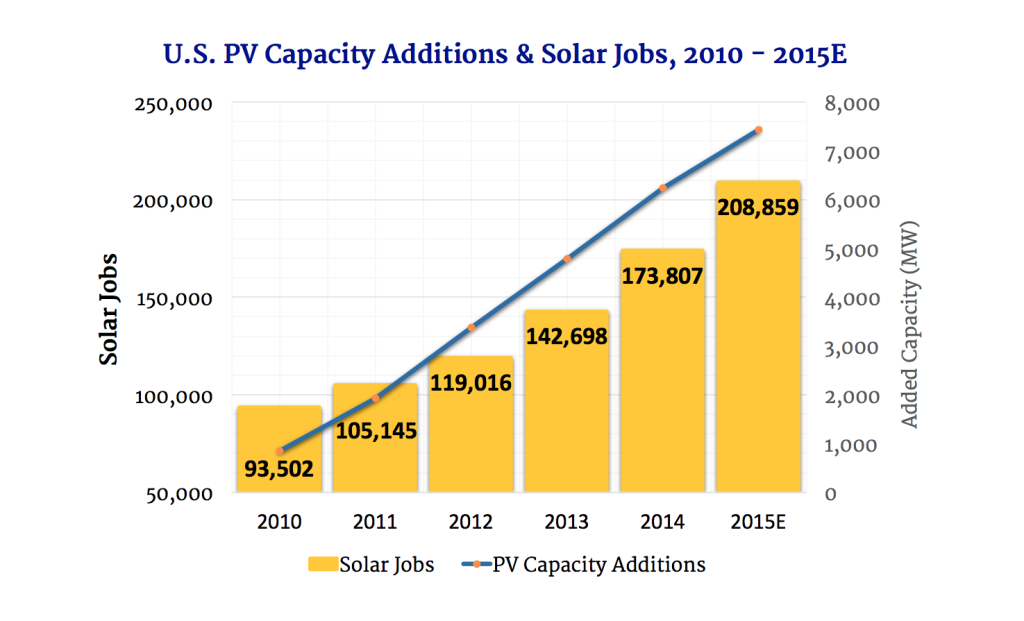
Graph from Solar Foundation
In 2015, the world’s largest solar power plant was finished in California after a company obtained a $1.5 billion loan from the government. The Desert Sunlight solar project created 440 construction jobs in the process, provides power to 160,000 homes, and expects a profit of 5-6 billion annually. A combination of large-scale solar projects and increased adoption of distributed solar at homes and businesses will keep solar jobs growing.
The coal, oil and gas industries are watching worriedly as their industries lose market share. Separate from the threat of renewable energy, record low oil prices in 2015 led to a loss of over 233,000 jobs in the oil and gas industries globally. The coal industry is experiencing a similar loss of profit, as earnings fell 25 percent in 2015 and coal mining jobs in the United States decreased by 4,000 between 2008 and 2013. Coal industry losses are more directly attributable to environmental regulations, which make burning coal more costly and thereby encourage the shift to renewable energy.
Instead of embracing the shift from fossil fuels to clean energy, one that we desperately need for the sake of the planet and public health, as an opportunity for economic growth and job creation, conservatives with a stake in oil and gas are doing everything in their power to slow the rise of solar.
With the job losses in the fossil fuel industry and the harmful consequences for our planet, it simply doesn’t make sense for global subsidies to fossil fuel companies to reach close to 500 billion annually. Not only is it a waste of money to prop up the fossil fuel industry instead of investing in profit-making solar projects, but fossil fuel companies and the Koch brothers use those subsidies to mount campaigns to block the widespread adoption of solar, and nowhere is it more evident than in Florida.
The Sunshine State ranks just 16th in solar production despite its high capacity to generate solar power because fossil fuel companies have worked to prevent the solar from gaining ground. Fossil fuels maintain a monopoly on utility companies, lobby for the state to put anti-solar policies in place and discourage solar through preventing companies and residences from selling excess power from solar panels and forcing those with solar panels to pay special fees on their utility bill. Therefore, most of Florida’s electricity, 84 percent, comes from gas and coal. It’s a losing war that the fossil fuel companies are waging though. Fossil fuel companies are fighting green energy tooth and nail, but the market trends are clear, and solar is ever expanding.
One of the most important victories for solar and wind was the extension of the solar energy investment tax credit through 2019. This is going to be very important in spurring on expansion of the solar industry as residences and commercial businesses will continue to get the 30 percent tax credit on solar energy projects, which was set to expire at the end of 2016. Bloomberg Finance predicts that because of the tax credit’s extension more “solar power will be installed over the next five years…than the total installed in history up to the end of last year.” Renewable energy is going to have the fossil fuel industry running for the hills.
If you’ve used a taxi or similar transportation service in a major U.S. city recently, you’ve probably heard of Uber or Lyft. Uber and Lyft are two mobile ride hailing companies that were both founded in San Francisco, California. Uber was founded in March 2009 and Lyft was founded in summer 2012. They facilitate peer-to-peer ridesharing and operate under the transportation network company (TNC) label. By summer 2015, Uber’s net worth was valued at $50 billion and Lyft’s net value was $2.5 billion.

Council Member Ann Kitchen Getting Fingerprinted – Photo by Jay Janner, Austin American Statesman
Uber and Lyft are great options for carpooling, for not having to deal with parking your car downtown, or for worrying about drinking and driving. They also provide convenience by simply using your smartphone to order and pay for a ride. So what’s all the fuss with them about? This past December, the Austin City Council passed an ordinance that, among other things, required all transportation network companies (TNCs), which includes Lyft and Uber, to fingerprint their drivers for background checks. The December ordinance set benchmark goals of having 25% of drivers fingerprinted by May 2016, with gradual increases, and then 99% compliance by February 2017.

South Congress Capitol View – Photo from Wikimedia
Public safety officials support of the fingerprinting ordinance as necessary for safety. Without fingerprinting, drivers could slip through the background check using false identities. Lyft and Uber are opposed to fingerprinting their “contractors” because they think their background checks are sufficient and that the ordinance opens the door to future regulation that they believe hampers innovation. Taxi drivers, pedicab operators and horse carriage operators are already subject to the same regulations though.

City Council Committee Meeting – Photo by Laura Skelding, Austin American Statesman
Lyft and Uber say that if fingerprinting happens, they’re leaving town. They don’t want to be subjected to regulations they think might stifle future business decisions or that defines them as taxi-like companies. If they’re associated with taxi services, they’ll be subjected to an array of additional rules. This is ironic because Uber and Lyft are in fact very similar to taxis: they provide transportation for passengers and receive payment in exchange. They are “taxi-like” and thus should be subjected to the additional regulations they want to avoid.
What about who the actual drivers are? According to Ben Wear (Austin American Statesman February 15, 2016, pg. B3):
At least ten Austin women filed complaints last year about sexual assaults – seven against ride-hailing drivers, three involving taxis. While the two companies use background checks that look at all 50 states, and they bar applicants with crimes of violence or theft, those background checks only look back seven years. So, someone could have committed a rape or even a homicide 10 or 20 years ago, even in Texas, and the ride-hailing companies likely would not find out about it.
In an undercover investigation, NBC Chicago hired several drivers and ran their own personal background checks on them. They found numerous tickets and questionable driving history. One driver had 26 tickets and one driver was an ex-con who had priors going back two decades including burglary, drugs, and assault. There are clearly people getting through their background check system that shouldn’t be driving for hire. Having the fingerprint submissions that the City Council proposed would make it easier for law enforcement to identify lawbreakers.
A political action committee (PAC) called Ridesharing Works for Austin formed in response to the fingerprinting mandate. The PAC made a petition to fight back against the City Council’s new TNC rules, and they gathered three times more signatures than they needed. The City Council could then either overturn the fingerprinting ordinance passed in December, or place it on the ballot of the next available election for the voters to decide. They went with the latter, so it’s up to Austin voters to decide on May 7.
The Uber and Lyft situation in Austin is a local example of a problem America is experiencing at a federal level – big money in government. The reason Uber and Lyft were able to gather so much support for their petition is because they contributed at least $50,000 in cash and services to the Ridesharing Works PAC. The PAC had canvassers go out, knock on Austin residents’ doors, and gather signatures. Many rideshare drivers also had the petition available in their vehicles for passengers to sign during their rides. Many inaccurately explained the issue to Austin residents as simply “Uber/Lyft vs. the city of Austin”. They told residents that the City Council is forcing Uber and Lyft to leave town, when in reality, if the two companies do leave, it’ll be on their own accord.
The money behind the petition against the fingerprinting ordinance is from big corporations. And those corporations are essentially funding Lyft and Uber’s campaign against safety regulations in Austin. This is exactly what we want to avoid in politics, and it’s happening right here in our city. Corporations coming up with their own rules and going to city hall to demand them is not the way government is supposed to work. It’s a government by the people and for the people, not by corporations and for corporations. If Uber and Lyft succeed in getting the fingerprint mandate overturned, it sets a dangerous precedent for the future. As citizens of the United States of America, we need to question how money from big corporations like Uber and Lyft is influencing our local legislation. Austin voters should consider this when they head to the polls on May 7th.
Posted in Consumers, Good Government, Safety, Transportation | Tagged Texas |
Monsanto has a bad track record when it comes to the safety of its products. From saccharin, to Agent Orange, to DDT, Monsanto has a history of producing and distributing chemicals that have serious health consequences. Most recently, the company has come under pressure for its herbicide, Roundup. After years of consumer concern, world-leading scientists at the International Agency for Research on Cancer (IARC) released a study in March 2015, stating they believed glyphosate, Roundup’s active ingredient, is “probably carcinogenic”. These findings have been echoed by the World Health Organization.

Chafer Sentry Herbicide Application
This news should bring shockwaves in regulatory policy, as glyphosate is by far the most used herbicide in the world. The use of this carcinogenic herbicide has become essential for thousands of farmers who are under contract with Monsanto to use Roundup Ready genetically modified (GM) seeds. Roundup Ready crops are most heavily applied with glyphosate and these include soy, corn, canola, alfalfa, cotton, sorghum, and wheat.
Countries such as Sri Lanka, and Bermuda have banned the use and importation of glyphosate, while Germany’s health ministers are spearheading a campaign to have the herbicide banned all across the European Union. For the US, the first instance of this can be seen in the California Environmental Protection Agency’s plan to begin labeling Roundup and other products containing the chemical as carcinogenic. Dr. Nathan Donley, a scientist at the Center for Biological Diversity, stated,
“As far as I’m aware, this is the first regulatory agency in the U.S. to determine that glyphosate is a carcinogen. So this is a very big deal.”
Glyphosate’s carcinogenic potential has been known to Monsanto and the U.S. Environmental Protection Agency (EPA) from long term animal experiments since the early 1980s, but the company has repeatedly dismissed such claims and refused to disclose the studies, buy claiming they contain “trade secrets”. After petitioning the EPA, Dr. Anthony Samsel, a research expert who has worked for the EPA, and as a hazardous materials expert, the United States Army Corps of Engineers (USACE), and the United States Coast Guard (USCG), received the lab documents.
One study shows how mice exposed to glyphosate produced renal tubular adenomas, which are tumors in kidney cancer, along with developing hepatocyte hypertrophy, which is a sign of liver cancer. In addition, lab findings show how glyphosate glyphosate stops the body from absorbing selenium, which leads to thyroid cancer growth. As a result, the EPA labeled glyphosate a Class C carcinogen in a March 4, 1985 EPA review. The Class C carcinogen label means there is suggestive evidence of carcinogenic potential. This classification was changed by the EPA just six years later to a Class E category which suggests “evidence of non-carcinogenicity for humans”. Is it a coincidence that this change in glyphosate’s classification transpired during the same period that Monsanto was producing its first Roundup-Ready GM Crops?
Posted in Food, Health, Toxics | Tagged Agriculture, biotechnology, cancer, GMO, health, Monsanto, Texas |
Wednesday, CPS Energy of San Antonio announced that they are writing off the nearly $400 million already spent to develop two new proposed South Texas Project nuclear reactor units.
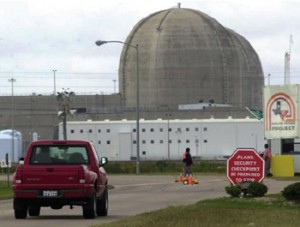 “The NRC can license these reactors, but they won’t get built,” said Karen Hadden of the Sustainable Energy and Economic Development (SEED) Coalition. “Renewable energy is cheaper these days and much safer. Nuclear power creates radioactive waste that remains deadly for hundreds of thousands of years.”
“The NRC can license these reactors, but they won’t get built,” said Karen Hadden of the Sustainable Energy and Economic Development (SEED) Coalition. “Renewable energy is cheaper these days and much safer. Nuclear power creates radioactive waste that remains deadly for hundreds of thousands of years.”
“CPS’ decision shows that proposed nuclear reactors are worthless. There’s no market for their rate raising, high-cost, high-risk power,” said Tom “Smitty” Smith of Public Citizen’s Texas office. “The proposed reactor price tag rose from $5.9 billion to $18.2 billion, even before a license was ever issued. Delays, construction problems and lawsuits are the norm for nuclear reactors. They cost so much that even with all the federal subsidies, no bank will loan money to build them. CPS did the smart thing and wrote off this worthless investment”
You can read about this fiscal decision on their blog by clicking here. You can read the excerpt regarding the financial write-off from the post below:
In FY 2015-16, we also made the decision to financially write-off our investment in the proposed South Texas Project Units 3 & 4. The decision to write-off the investment should be seen solely as an “accounting decision.” CPS Energy will retain a legal interest in the project, which aligns to our perspective that nuclear is a significant part of our local and the broader national energy portfolio and will continue to be an important, carbon free and economic fuel type, as well as a good alternative to help counter volatile fuel prices.
We continue to argue that, for a variety of reasons – stated briefly above, nuclear energy should not be considered the future of the nation’s broader energy portfolio. CPS’s financial decision is one such indicator, in spite of the caveat in their statement.
Posted in Nuclear | Tagged #SolarSiNuclearNo, CPS Energy, south texas nuclear project, Texas |
If you felt like 2015 was exceptionally warmer than usual, you weren’t alone. Last month, scientists declared 2015 the hottest year on record. Some of this heat can be attributed to the El Niño weather pattern releasing heat from the Pacific Ocean into the atmosphere, but most of the record-breaking heat is from climate changes caused by human-related greenhouse gas emissions.
NASA, the National Aeronautics Space Administration, and NOAA, the National Oceanic and Atmospheric Administration, both collected data that showed that 2015 was between 0.23-0.29 degrees Fahrenheit hotter than 2014. This number may seem small and insignificant, but in terms of global temperature, it’s a big deal. Thomas Karl, director of NOAA’s National Centers for Environmental Information emphasized that point:
This record, we literally smashed. It was over a quarter of a degree Fahrenheit, and that’s a lot for the global temperature.
In comparison to average temperatures in the 20th century, and not just 2014, 2015 was 1.62 degrees Fahrenheit higher.
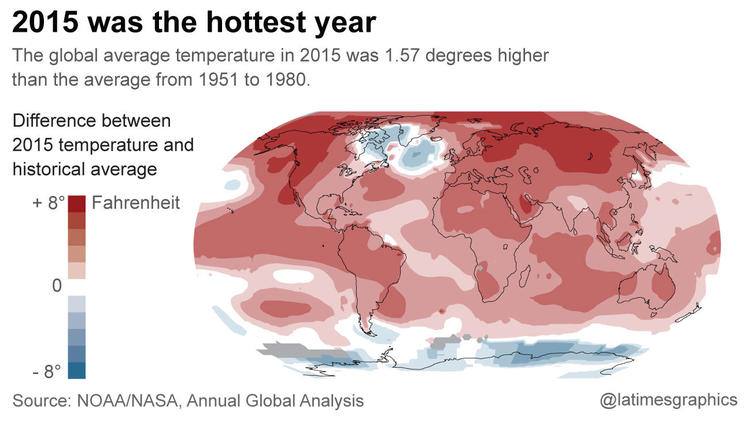
 The severe heat last year was felt around the world. There were record-high temperatures in the triple digits across Europe in June and July in Spain, Portugal, France, the U.K., Germany, and Poland. In May, India experienced 120 degree days that melted the asphalt, killing 2,500 people. In June, 1,200 people died in Pakistan after temperatures reached 113 degrees. When the atmosphere is warmer, it can hold more water vapor, which can cause an increase in heavy rains. The recent catastrophic floods in the eastern U.S. are evidence of this. El Niño is also disturbing atmosphere circulation which is causing some worldwide weather extremes like the drought in southern Africa.
The severe heat last year was felt around the world. There were record-high temperatures in the triple digits across Europe in June and July in Spain, Portugal, France, the U.K., Germany, and Poland. In May, India experienced 120 degree days that melted the asphalt, killing 2,500 people. In June, 1,200 people died in Pakistan after temperatures reached 113 degrees. When the atmosphere is warmer, it can hold more water vapor, which can cause an increase in heavy rains. The recent catastrophic floods in the eastern U.S. are evidence of this. El Niño is also disturbing atmosphere circulation which is causing some worldwide weather extremes like the drought in southern Africa.
So how will Texas be affected by this global climate change? With its location and vast size, Texas has a wide range of vulnerabilities to the effects of climate change. A study done by the Risky Business Project found that Texas will be one of the states that is most negatively affected by climate change.
- Decrease in worker productivity and crop yields.
- Sea level rise of 2 feet in Galveston.
- The number of extremely hot days per year (temperatures exceeding 95 degrees) will more than double from 43 to 106 days per year.
- About 4,500 additional heat-related deaths per year.
- A $650 million per year increase in storm-related losses along the coast, bringing the state’s annual damages to more than $3.9 billion.
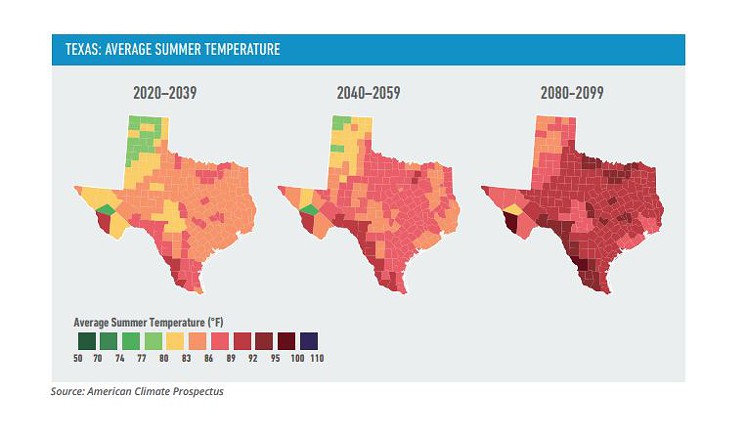
The Risky Business Project’s mission is to convince business leaders in Texas that climate change is a true risk. This will not be easy since Texas lawmakers routinely dismiss climate change. Regarding the news that 2015 was the hottest year, NASA head Charles Bolden said, “This announcement is a key data point that should make policymakers stand up and take notice – now is the time to act.” That it is, Bolden.
Posted in Climate Change, drought, Global Warming | Tagged climate change, record heat, Texas |
Republicans have been waging a war against public health regulations in the United States for longer than I’ve been alive. One of the latest worrisome developments in this trend is the push-back from many conservative states, Texas among them, against the Environmental Protection Agency’s (EPA) new standards regarding ground-level ozone, otherwise known as smog.
When the last revision of ozone standards was completed in 2008, the standard, at 75 parts per billion (ppb), was set to allow much higher levels of pollution than many environmental and public safety groups felt was necessary to protect the public well-being. The panel in charge of advising the EPA on the new standard, the Clean Air Scientific Advisory Committee (CASAC), unanimously recommended a standard between 60 and 70 ppb. However, the Administrator of the EPA at the time was appointed by President Bush, served conservative interests, and chose to adopt 75 ppb instead.
Now, thankfully, under the new regulations finalized in October of 2015, states will have to meet a standard of 70 ppb after the CASAC again recommended a standard between 60 and 70 ppb. With the difficult political climate right now, it’s clear the EPA believed that adopting the least aggressive option while still improving public health would meet with the least resistance. However, it has met considerable resistance from the current Congress, as 10 bills have been introduced attempting to delay the implementation of these standards, with some bills even attempting to prohibit funding the EPA.
The estimated cost of implementing the new 70 ppb standard is $1.4 billion, whereas choosing a standard of 65 ppb would have raised the cost of implementation to $16 billion. States have until 2020 to reach 70 ppb, with the most polluted areas allowed as long until 2037 to reach attainment. This should be a win for Republicans, so it’s difficult to understand the current rhetoric being thrown around by those who are objecting to the new standard. Texas Attorney General Ken Paxton claimed in a press release “The EPA’s new ozone rule is not supported by scientific data” and then went on to complain that it will require “costly new regulations that will harm our economy and kill jobs.”
These are ridiculous assertions. Here’s why:
Firstly, a brief outline of the process for reviewing Ozone NAAQS (standards) should be enough to refute the claim that there is no science behind the rule: Federal EPA scientists reviewed 2,300 scientific studies to complete the preliminary Integrated Science Assessment. After the EPA prepared a Risk and Exposure Assessment to identify at-risk populations and health impacts, a Policy Assessment summarized the information in the previous two documents and provide the EPA Administrator with policy options.
Then, as required under the Clean Air Act, an independent scientific advisory panel, the CASAC, was formed to review the entire process. The panel members are generally from academia and private research institutions. Leading experts on health and environmental effects of specific pollutants are then regularly called in to supplement the panel’s considerable scientific knowledge.
Secondly, the health benefits were estimated between $2.9 billion and $5.9 billion, clearly outweighing the $1.4 billion cost. The projected health benefits come in the form of less heart and lung diseases and a reduction in premature deaths. Most notably, 320 to 660 premature deaths could be avoided with adoption of these new regulations, which account for 94 to 98 percent of the EPA’s total monetized benefits of the new standards.
 Under the new standards we can prevent:
Under the new standards we can prevent:
• 11,000 cases of upper and lower respiratory symptoms
• 230,000 cases of exacerbated asthma
• 188,000 days when people miss school or work from illness related to smog
• 340 cases of acute bronchitis
• 960 hospital admissions and emergency room visits
To say that these costly regulations will not be worth the benefits is to say that one does not care about or value human life or quality of human life.
Republicans have been fighting for the right to disregard human life, environmental health and EPA regulations for a long time. Most recently, the 112th Congress attempted to pass legislation that would have required the EPA to take costs into consideration when setting standards. As it is now, the EPA is supposed to place public and environmental health above economic costs. The current Congress has again introduced legislation requiring the EPA to take costs into account when setting future standards.
In their 2015 brief on the new Ozone NAAQs, the Congressional Research Service highlights eight of the ten plus bills that have been introduced by the current Congress that attempt to delay or prevent implementation of the new standards. Texas is spearheading the effort to subvert the EPA, with four of the highlighted bills coming from Texas Representatives. All the eight bills are backed by Republicans. North Texas Representative Sam Johnson, introduced legislation that would “provide no funds made available under any act may be used by EPA to implement any ozone standard.” On top of that, Texas is suing the EPA, in an attempt to overturn the new ozone standards. It is clear that this lawsuit and these many legislative attacks are acts of Republican disbelief in science and disregard for public health.
Posted in Air Quality, Ozone | Tagged Texas |
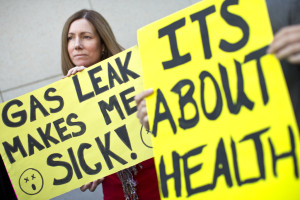
Porter Ranch – photo by Maya Sugarman KPCC
The massive natural gas leak in Porter Ranch, CA, just outside of Los Angeles, has been temporarily capped. That’s the good news. The bad news is that the leak isn’t yet permanently stopped and that it has already done incredible damage over the 111 days it spewed methane and toxic chemicals into the air.
The state of emergency called by Governor Jerry Brown is still in effect for what is being named the largest environmental disaster since the BP oil spill. Over 94,700 metric tons of methane has escaped since October 23, which is one of the largest leaks ever recorded. This incident has taken California two steps back in its progress towards greenhouse gas emissions reductions especially since methane is 87 times more potent of a greenhouse gas than carbon dioxide. For perspective, the amount of methane released so far from the natural gas leak will have the same impact on climate over the next twenty years as emissions from seven coal power plants. Despite these environmental crimes, not one person has been arrested, although this past week, the citizens of Los Angeles County have begun taking legal action.
Southern California Gas Co (SoCal Gas), a subsidiary of Sempra Energy, is the responsible company for the Aliso Canyon Methane Leak, and is finally facing charges for this disaster. District Attorney Jackie Lacey announced the criminal charges filed against SoCal Gas for failing to immediately report the gas leak at its Aliso Canyon facility to the proper state authorities. The site leaked for three days before SoCal Gas officials contacted the city’s fire department.
Major public health concerns are also leading to lawsuits. Residents across the county are reporting health issues such as nose bleeds, female health problems (excessive bleeding), rashes, vomiting, headaches, and dizziness, and have packed town hall meetings voicing their concerns. One Porter Rach resident, Christine Katz, stated, “Even though you can’t see the gas, it’s there. And that’s the saddest part — people don’t understand it. Because it’s not a mudslide, it’s not an earthquake. You just don’t see the devastation, but it’s there.”
SoCal Gas has yet to release a full listing of the chemicals being emitted from the leak, furthering distrust and anxiety from the community. Local law firms have organized a website (www.porterranchlawsuit.com) for citizens to reach out if they have been impacted. More than 25 lawsuits have been filed pursuing damages from the SoCal Gas and Sempra Energy. For example, a family of an elderly woman has filed a wrongful death lawsuit against the gas company, claiming that the leaking chemicals led to the worsening of her health and untimely death this past January.
Legal actions will certainly hurt these gas companies financially, but is this an effective way of enforcing the law? History says no. Time and time again, environmental crimes are punished with fines, and these disasters continue to happen putting the public at risk. New regulations, transparency, and stricter criminal enforcement on the individuals responsible very well could bring justice in these incidents.
Crimes committed under a corporate veil are still crimes and should be treated as such. No amount of money will ever reverse the harsh health and environmental effects the Aliso Canyon Methane Leak is having on the region. But we can put into place policies that make corporations take the environmental risks of their operations much more seriously. A proactive justice process would be exponentially more effective means of dealing with environmental crimes than merely reacting after the fact.
Posted in Climate Change, Fracking, Global Warming, Health, Pollution | Tagged California, climate change, methane emissions, natural gas leaks, porter ranch, Public Citizen, Texas |
 South Texas Nuclear Reactors Can’t Compete With Renewables and Risk Financial Meltdown
South Texas Nuclear Reactors Can’t Compete With Renewables and Risk Financial Meltdown
Consumers Will Bear the Costs of New Reactors
Public Citizen, the SEED Coalition and the South Texas Association for Responsible Energy are opposing a decision by the U.S. Nuclear Regulatory Commission (NRC) to approve construction of two new nuclear reactors at the South Texas Project nuclear plant southwest of Houston. Market conditions, currently dominated by low natural gas prices, make the economics of nuclear power challenging, the groups said.
Reacting to the NRC’s move, even the former CEO of NRG Energy admitted markets have little interest in new nuclear power plants. But the prospect of billions in public subsidies can shelter shareholders from the financial albatross that is nuclear power, while exposing taxpayers to all of the risk.
“At a time when market-fueled wind power in Texas has pushed power prices at times close to nothing, it makes no sense whatsoever to continue to approve permits for another financial disaster-in-waiting,” said Tom “Smitty” Smith, director of Public Citizen’s Texas office. “The proposed nuclear reactors would produce energy that is too costly to consume. The most recent price tag of over $18 billion is three times the original estimate. The power that the reactors would produce would cost three to four times more than wind, solar or natural gas in today’s market, so it can’t compete.”
“We simply cannot build our energy future around an industry plagued by soaring and uncertain costs, project delays and an unmanageable lethal bi-product,” said Tyson Slocum, director of Public Citizen’s Energy Program. “The Vogtle nuclear facility in Georgia and the Summer nuclear facility in South Carolina are both three years behind schedule, and each is expected to come in billions over its original budget. These poor performances are indicative not only of the current state of the nuclear industry, but of its past. The costs of building 75 of the existing nuclear power plants in the U.S. exceeded industry quoted estimates by more than 300 percent, and there is nothing to suggest these new reactors will be any different.”
Under current plans, Toshiba America Nuclear Energy Corporation (TANE) will assume exclusive, principal funding authority for the project. But the Atomic Energy Act prohibits the licensing of reactors that are owned, controlled or dominated by a foreign corporation or foreign government. Opponents have contended that because TANE is a wholly owned subsidiary of Toshiba America, Inc., a Japanese corporation, the company is ineligible for licensing.
“The reactors will be 93 percent owned by a Japanese company,” said Susan Dancer, president of the South Texas Association for Responsible Energy. “If the proposed reactors ever get licensed and built, orders for operation will come from foreign owners. Federal law prohibits foreign companies from owning nuclear plants because today’s friends may be tomorrow’s enemy. And what if they are focused on cost-cutting and not safety? Japanese investors want us to trust them, but little protection was afforded to the Japanese people following the Fukushima disaster.”
“The NRC is pushing the interests of corporations, not citizens or ratepayers in moving toward licensing two proposed nuclear reactors in Bay City, Texas,” said Karen Hadden, executive director of the SEED Coalition, a group that has led intervention in the licensing process. SEED plans to appeal the NRC’s decision.
Note: Late Tuesday, the U.S. Supreme Court halted implementation of the U.S. Environmental Protection Agency’s (EPA) Clean Power Plan until legal challenges are resolved. Below are two statements from Public Citizen experts.
Statement of David Arkush, managing director, Public Citizen’s Climate Program:
We are extremely disappointed by the Supreme Court’s stay of the Clean Power Plan. The stay will delay progress on climate change at a time when we need much more assertive action. We urge states to continue writing their implementation plans under the rule while the litigation is pending, which they are free to do. State plans can benefit consumers tremendously by lowering electricity bills and boosting public health. Electric utilities are increasingly saying that the Clean Power Plan is workable. We cannot afford to lose any time working to stop climate change from devastating our economy and our planet.
Statement of Tom “Smitty” Smith, director, Public Citizen’s Texas office:
The Supreme Court yesterday stayed implementation of the EPA’s plan to control carbon pollution. But it can’t suspend the rules of nature, and nature will prevail.
A delay in implementing the EPA’s clean power plan will be very harmful to Texans.
Texas’ leadership has its head in the sand, but Texas will get burned because our state is likely to suffer devastating consequences from climate change – heat waves, drought, agricultural losses, dried-up lakes and rivers, higher utility and insurance bills, increased early deaths and increased spending on health care.
No state emits more carbon dioxide from its power plants than Texas, and Texas would benefit tremendously from a shift in energy sources because of our vast renewable resources and our potential to reduce energy use through efficiency, both of which are lower-cost options than retrofitting coal plants, and both of which would put money into Texans’ pockets. We could export our clean renewable resources to neighboring states. We could save the $1 billion we send to Wyoming to buy coal each year and reinvest it in homegrown Texas energy resources, reducing our bills and creating jobs.
The energy sector is changing. As Texas Attorney General Ken Paxton said today, the changes in the energy sector will require planning. The challenge now shifts to the interim committees of the Texas Legislature to begin to develop plans to build new power lines and dispatch systems needed to meet the needs of the new energy sector that is developing, with or without new clean power rules.
Posted in Climate Change | Tagged Texas |


